G.Sargent–K.Ammann
Route 20 Chess Club
Freeport, Illinois, June 15, 2010
1.e4 e6 2.d4 d5 3.exd5 exd5 4.Be3?
A non-book move upon which ChessBase looks dimly, giving white only a 42 percent chance of winning. Jacques Mieses apparently loved this line; he seems to have played it exclusively from 1889 to 1905. (Later in life, he switched to 4.Bd3.)
4...Nf6 5.c4 c6
Actually, my first move -- as I'm finding nothing at all to my liking -- is 5...c5. This is followed by 6.dxc5 Bxc5?? 7.Bxc5. I shake my head sheepishly, and we return to the position after 5.c4. (Fritz smacks its virtual forehead and tells me to just play 5...Bb4+, then castle.)
6.Nc3 Bb4 7.a3 Bxd3+
"I guess I shouldn't be writing checks I'm not going to cash," I say.
8.bxc3 0-0 9.Nf3 Ne4
I see the unprotected pawn on c3 and smell blood.
10.Qc1
The right idea, inaccurately executed. 10.Qc2, the best move in the position, gives white a slight advantage. 10.Qc1 gives Gary a nearly equal disadvantage.
10...Bf5 11.Be2 Nd7 12.0-0 Qa5 13.cxd5
After the game, Gary commented that he "lost a pawn there somewhere" but wasn't entirely sure where. According to Fritz, this is where. Gary's pawn capture threatens further damage to my pawn structure -- but my next move threatens a piece capture and an ugly fork, making it the more pressing issue. (As an alternative, 13.Nd2!?, vacating f3, gives white's e2-bishop a chance not only to slip out of the capture but to shut down the idea of the fork with 14.Bf3.)
13...Nxc3
Threatening the devastating 14...Nxe2+. 13...Qxc3?, in contrast, is a fiasco: 14.Nh4 Bg6 15.f3 Qxc1 16.Rfxc1 wins two pawns (or the bishop, if white foolishly plays 16...cxd5?, which also leaves white's c-rook an unimpeded path to the seventh rank), while 13...cxd5?! 14.c4 allows the knight outpost to be undermined, and after 13...Qxd5 14.c4 Qd6 15.Qb2, you can practically hear the black pieces whimper, "Please don't hurt me."
14.Qe1 Nxe2+ 15.Qxe2 Qxd5
The knight looks pinned, but the check proves that it isn't, giving my queen time to scoot out of the way -- and to finish the pawn transaction.
16.Nd2 Rfe8 17.Qc4
I've spotted another lovely tactic . . .
17...Qxc4 18.Nxc4 Bd3 19.Nd6
. . . and missed one of Gary's. Still, there's nothing bad in this for me: I'm up a pawn, and it's an even trade that ends with my rook controlling the open e-file.
19...Bxf1 20.Nxe8 Rxe8 21.Kxf1 b5
A stumble. I'm thinking that we're even on the kingside and that there's no obvious goal in the center, so I may as well press on the queenside, where I have a significant pawn advantage. But why operate on the flank when I'm stronger in the center as well? Plus, 22.Rb1 is no real headache, but 22.d5!? could be. Thus, 21...Nf6 is a useful preventive move. 21...b5, in contrast, just gives Gary a target; I still have an advantage, but it's no longer decisive.
22.Rc1 Rc8 23.d5 c5
My pawn majority is intact, and I'm holding onto my material, but now Gary has a passed pawn.
24.Rb1
A non-threat. My active pieces are both tied down guarding a stupid pawn, making this a fine moment for Gary to bring his king into the action with 24.Ke2.
24...a6 25.a4
This just invites me to slip past with 25...b4 . . .
25...Rb8
. . . but I guess I haven't gotten the invitation.
26.axb5 axb5 27.Bf4 Rb7 28.Ke2
Here he comes!
28...c4
Not the best idea available to me. 28...f5 gives the black king a shorter path to his diminutive nemesis.
29.Bd2 Nf6 30.d6 Nd7
The blockading move is wholly unnecessary.
31.Bb4 Ra7 32.Ke3
Gary's king is threatening to slip behind my advanced pawns and knock them out. Where did my advantage go?
32...Nb6 33.Kd4 Nd7 34.Kd5 Ra2
I'm not paying enough attention to that open e-file. Re1 presents the risk of a back-rank mate. The thing for me to do right now is to push an h-pawn and give my king room to breathe.
35.Bc5??
Gary can cause me all kinds of headaches with 35.Kc6! and 36.Kxb5. This move, on the other hand, allows me an opportunity to trade off that bothersome bishop with 35...Rd2+ 36.Kc6 Nxc5 37.Kxc5.
35...c3 36.Kc6
36.Rxb5 leaves nothing to chance, and 36...c2 37.Be3 keeps my c-pawn from promoting.
36...c2??
Allows intolerable pressure in the form of 37.Re1! Nf6 38.d7.
37.Rc1??
It must be getting toward the end of the night. At this point, I spot what I think is another clever tactic:
37...Ne5+ 38.Kxb5 Nd3??
This slick-looking triple fork is actually a blunder, as it allows 39.d7! Rb2+ 40.Ka5 Rb8 41.Rxc2 -- and now it's white who's ahead in material, his d-pawn a ticking time bomb that forces black to cower in the corner with 41...Ne5 42.Ba7 Rf8. Gary gets the first part of my punishment right, but not the second.
39.d7! Rb2+ 40.Kc6
Allowing my knight to throw himself on the bomb with 40...Ne5+ 41.Kc7 Nxd7 42.Kxd7.
40...Rb8
Committing my rook to stopping Gary's d-pawn from promoting is a terrible idea. 41.Bd6 Rd8, and it might as well be locked in a cage.
41.Kc7
A clumsy move that hangs the bishop and also allows white to neutralize the d-pawn with 41...Nxc5 42.Kxb8 Nxd7+. "Driving home, it occurred to me that given the back-rank threat, 41.Rxc2 instead of the immediate 41.Kc7 is probably sufficient for a draw," Gary says, but he's wrong -- 41.Rxc2 is probably sufficient for a win. After 41...Ne5+ 42.Kc7 (or 42.Kd6) 43.Nxd7 Kxd7, white is a bishop ahead in an otherwise symmetrical endgame.
41...Nxc1??
An incredible blunder, allowing the d-pawn to promote with threat of mate after 42.Kxb8 -- but what's even more incredible is that Gary misses this too.
42.d8Q+ Rxd8 43.Kxd8 Nd3 44.Be3
The threat from Gary's d-pawn gone, my own passed pawn miraculously alive, yet with Gary's bishop covering its promotion square, I proceed to end the game with one opportunistic move. What is it? (Highlight to reveal answer.)
44...Nxf2!? 0-1 If white takes the knight, the pawn will promote; therefore, 45.Ke7 Nd3, and white must part with his bishop on the promotion square, leaving black ahead by a knight and a pawn.

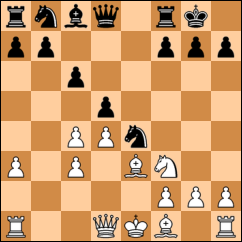
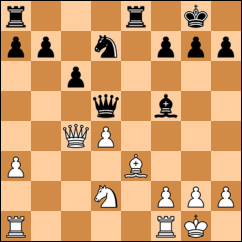
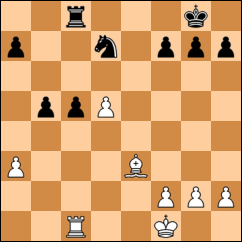
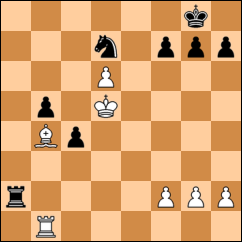
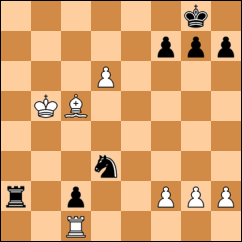
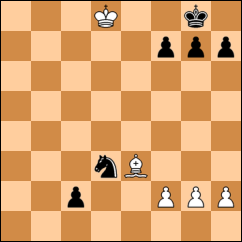



0 comments:
Post a Comment